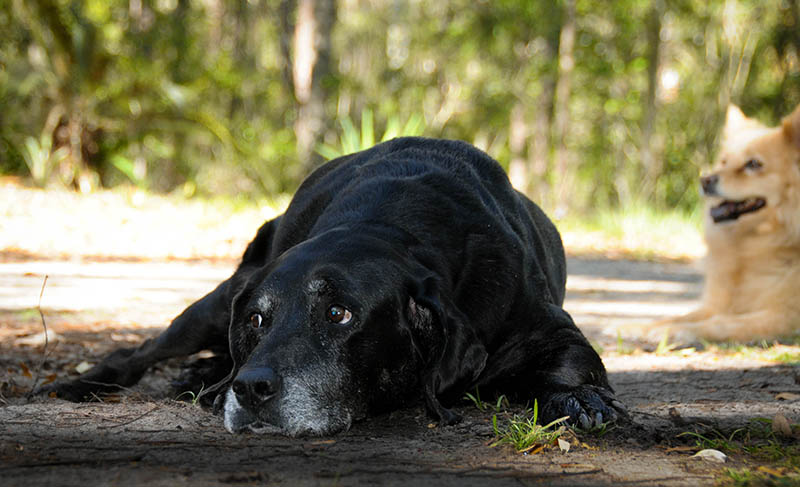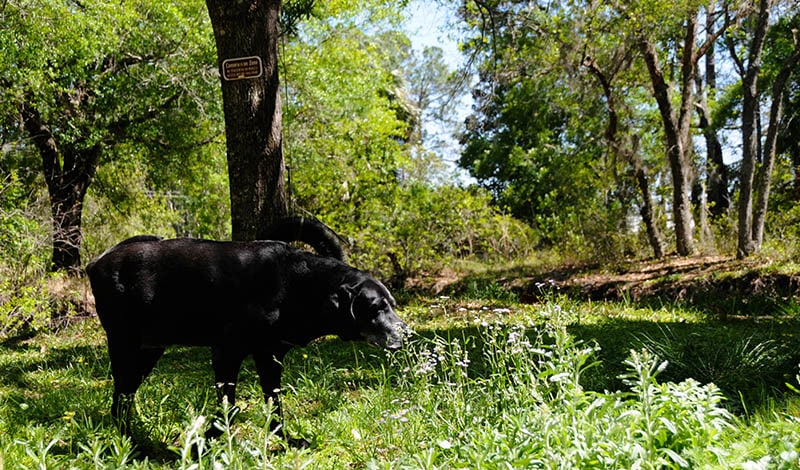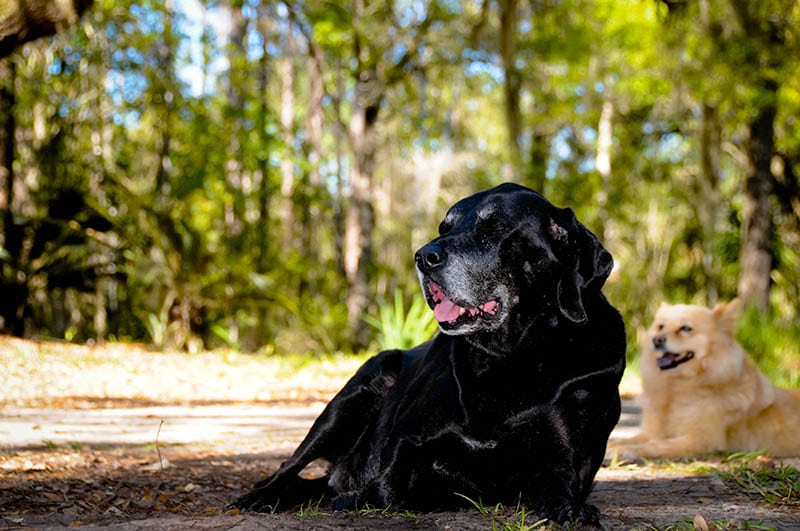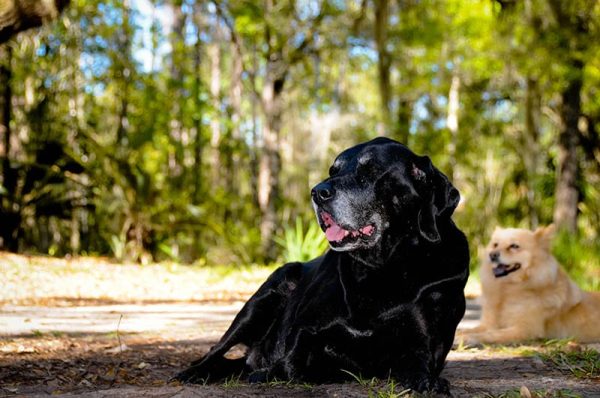Click Below to Skip Ahead
Are you considering adding a new furry family member? A Bloodhound Lab mix (or Labloodhound) might be the perfect fit! These pups are a rare and loving combination of a Bloodhound and a Labrador Retriever. But before deciding, it’s essential to learn about their appearance, personality, training, and health. Let’s dive in!
Breed Overview
Height:
22–27 inches
Weight:
60–100 pounds
Lifespan:
10–13 years
Colors:
Brown, black, white and brown, black and tan, liver and tan, red, yellow, chocolate
Suitable for:
Active individuals or families, homes in the country or the suburbs, and households with kids
Temperament:
Gentle, active, loyal, loving, sensitive, intelligent, vocal, friendly, outgoing, gets along with other pets
The Bloodhound Lab mix is a unique and uncommon breed resulting from combining two distinct species. Although there may have been unintentional breeding in the past, intentional crossbreeding of this mix has likely become more prevalent in recent years due to the increasing popularity of hybrid canines.
This dog is quite big, usually standing between 22 to 27 inches tall and weighing anywhere from 60 to 110 pounds. When you see this pet for the first time, you’ll notice how strong and athletic they look.
Bloodhound Lab Mix Puppies
Looking for Bloodhound Lab mix puppies can be pretty tough. If there aren’t any around you, you might have to hop on a waiting list. But when you find a breeder, ensure they’re legit and only breeding with healthy canines. Don’t be afraid to ask for proof of those health tests and even meet the mother and both parents if possible. This will give you peace of mind that the puppies come from a trustworthy source and will likely be healthy.
The most reputable breeders will prioritize the well-being of their dogs and puppies, treating them like members of their own family. If any animals appear malnourished or sick, or if the mother displays aggressive tendencies, it is advisable to explore alternative options. This approach ensures that only the healthiest and happiest dogs are bred, resulting in loving and well-adjusted puppies.
You’re probably aware of their boundless energy if you’re lucky enough to have a Labloodhound! It’s crucial to ensure that they remain healthy and active through regular exercise, such as taking them for walks, runs, and swims. However, remember that Labloodhounds should be exercised within a fenced yard to prevent them from wandering off. Additionally, since their coats are pretty thick, you should avoid exercising them during the hottest parts of the day to prevent them from overheating.

Temperament & Intelligence of the Bloodhound Lab Mix
Certain temperaments and instincts will be passed down from parent breeds. This can be seen in Labradors, who tend to have a strong inclination towards retrieving, and Bloodhounds, who often get caught up in following scent tracks when outside. If you adopt a Bloodhound Lab mix puppy, they may inherit either of these predispositions.
Labradors are such lovable and friendly canines when they are appropriately socialized. However, Bloodhounds may sometimes have different levels of patience around children, strangers, or other animals. That’s why it’s so important to socialize your mixed breed pup from an early age, to help them be more comfortable and less fearful or aggressive around others.
This breed is known for their love of people! They aren’t the most protective, but they make up for it with their affectionate, curious, and playful personalities. Just remember, they don’t like to be left alone for too long, so make sure to give them lots of attention.
Are These Dogs Good for Families? 👪
The Bloodhound and Labrador Retriever are both such sweet pets! They’re outgoing, friendly, and love spending time outdoors. So, the mix of these two will result in a sweet and affectionate pup. They’re sure to make friends with everyone they meet, although they may need a little time to warm up to new people. They’ll be the happiest dogs around with a loving family and some fun outdoor activities!
Does This Breed Get Along with Other Pets? 🐶 😽
Labloodhounds are known for their amiable nature towards other animals, making them a great addition to multi-pet households. This breed’s composed temperament means that they seldom engage in conflicts with smaller dogs or felines, allowing for peaceful and harmonious coexistence.
However, if you’re thinking about bringing a new pet home, you have to consider how they’ll get along with your current furry friends. Just like humans, animals can have their own personalities and preferences. It would help if you allowed your Labloodhound puppy to socialize with other dogs to ensure they develop proper social skills. This way, they can learn to differentiate between playtime with family pets and their natural hunting instincts. By taking these precautions, you can ensure a safe and enjoyable experience for all animals involved.

Things to Know When Owning a Bloodhound Lab Mix
Food & Diet Requirements 🦴
You must consider your pet’s size, age, and activity level when determining their appropriate daily food intake. It is recommended to provide high-quality dog food that meets their nutritional needs in the correct quantity to ensure they maintain a healthy weight and stay active. Furthermore, you should include identifiable sources of healthy fats and proteins in their diet.
But don’t overfeed your Labloodhound, as this can exacerbate health conditions and lead to unnecessary weight gain. By following these guidelines, you can help ensure your beloved pet remains healthy and happy for years to come.

Exercise 🐕
If you’re considering adopting one of these puppies, it’s good to know that their parents are big fans of staying active. So, these pups will probably have that same energy and need daily exercise. Whether it’s playing fetch, swimming, or even trying out some scent work, there are plenty of fun ways to keep them moving and entertained. Plus, keeping their minds stimulated is just as important as maintaining their bodies.
Training 🎾
You should take note of the Bloodhound Lab mix’s sensitive nature and respond accordingly during training. Positive reinforcement methods work best with these dogs, and they are known to be food-motivated and enthusiastic learners. Consistency is key to establishing proper habits and fostering a strong bond with your furry companion. So, make sure to keep this in mind as you embark on your training journey with your beloved pooch.
You may want to socialize your pet by gradually introducing them to different people and animals. One helpful way to achieve this is by taking them to a dog park, where they can interact with other pups and their owners. However, if you notice that your Labloodhound is struggling and having difficulty adapting to social situations, it may be a good idea to seek the assistance of a professional dog trainer. With the proper guidance and training, your furry friend will be able to develop the social skills and confidence they need to thrive in any environment.
Grooming ✂️
Maintaining a regular grooming routine is crucial for ensuring your furry friend’s health and physical appearance. This includes brushing their coat to prevent matting and tangles, cleaning their teeth and nails to avoid any potential dental or paw-related issues, and keeping their ears clean to prevent infections. For a Labrador Retriever and Bloodhound mix, brushing their coat at least three to four times per week is recommended to keep them in optimal condition and remain comfortable and happy.

Health and Conditions 🏥
This hybrid breed is fairly healthy overall, but may suffer from the following health issues:
- Thyroid disorders
- Eye problems
- Progressive retinal atrophy (PRA)
- Luxating patella
- Ear infections
- Arthritis
- Cardiac problems
- Gastric dilatation-volvulus (GDV), or bloat
- Hip dysplasia
- Elbow dysplasia
Male vs Female
Aside from the noticeable biological differences, male and female dogs may exhibit different behaviors and personalities. Un-neutered males tend to be more likely to run away from home in search of a mate. Meanwhile, un-spayed females experience “heat” twice yearly. Males do not experience heat, but if left un-neutered, they may continue to display dominant behavior and seek out females in heat.
Overall, there isn’t a significant difference between males and females in terms of temperament. What really influences your pet’s behavior is their environment and training, not their biological sex. Therefore, whether your furry friend is male or female, proper training and a safe and nurturing environment are vital to ensuring they become well-behaved and happy pets.
3 Little-Known Facts About the Bloodhound Lab Mix
1. Their Appearance Is Unique and Unpredictable
With mixed canines like the Bloodhound Lab, there is a lot of unpredictability regarding the traits that puppies may inherit. This is because any characteristic from either parent can be passed down, resulting in a litter of puppies with different features. So, it’s crucial to be ready for any outcome.
The typical appearance of a Bloodhound Lab mix is characterized by a short and dense coat, which is a common trait inherited from both parent breeds. They are likely to have a long and slightly curved tail, which can either be thin like the Bloodhound’s or thicker like the Labrador’s. Moreover, they may inherit the same wrinkled and drooping excess skin on their face as the Bloodhound parent, which adds to their unique look.
2. Their Labrador Retriever Parent Is One of the Most Popular Breeds in America
The Labrador Retriever, originating from Newfoundland off the northeastern Atlantic coast of Canada, is a breed that has captured the hearts of many in America. The American Kennel Club recognized these incredible canines in 1917. Their intelligence, eagerness to please, and willingness to work hard make them very special. Labradors are highly valued in many fields, including service dog work, search and rescue, bomb and drug detection, and therapy dog work. It’s no surprise that they’re among the most popular choices for dog lovers.
3. Their Bloodhound Parent’s Capacity to Detect Scent Is Unmatched
The Bloodhound is an incredibly impressive canine! The American Kennel Club officially recognized these pups in 1885. From their origins as skilled hunters of wild boar, deer, and rabbits, these pups have evolved to become expert trackers since the Middle Ages. Descending from the hounds kept at the Abbey of Saint-Hubert in Belgium, they’re affectionately known as “le chien de Saint-Hubert” in French.
But here’s where things get really interesting—the Bloodhound’s nose is out of this world. They can pick up on human scent from great distances, even days after the person has left the area. Their sense of smell is combined with an instinct to track and follow, making them one of the top scent hounds in the world. It’s no wonder that police and law enforcement worldwide rely on these pups to track down missing people, escaped prisoners, and even lost pets.

Final Thoughts
The Bloodhound Lab mix is an excellent option for individuals seeking an active, friendly pet. They can be a loyal companion to join you in outdoor activities. This breed is well-known for loving extended walks and accompanying their owner during bike rides. However, obtaining your pet from a reputable breeder is essential to ensure their health and well-being.
See also:
- Bloodhound Rottweiler Mix: Care, Pictures, Info & More
- Mastiff Bloodhound Mix: Care, Pictures, Info & More
Featured Image Credit: Csisson8, Shutterstock











